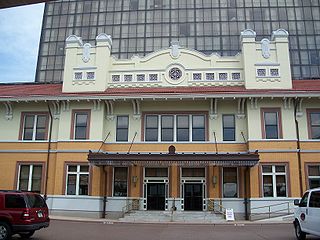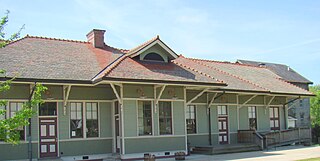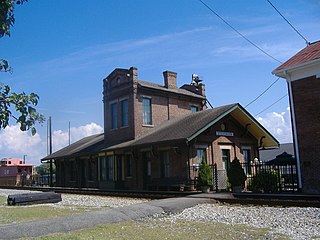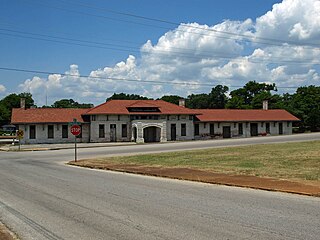
The Louisville and Nashville Railroad, commonly called the L&N, was a Class I railroad that operated freight and passenger services in the southeast United States.

The Union Station of Louisville, Kentucky is a historic railroad station that serves as offices for the Transit Authority of River City (TARC), as it has since mid-April 1980 after receiving a year-long restoration costing approximately $2 million. It was one of at least five union stations in Kentucky, amongst others located in Lexington, Covington, Paducah and Owensboro. It was one of three stations serving Louisville, the others being Central Station and Southern Railway Station. It superseded previous, smaller, railroad depots located in Louisville, most notably one located at Tenth and Maple in 1868–1869, and another L&N station built in 1858. The station was formally opened on September 7, 1891, by the Louisville and Nashville Railroad. There was a claim made at the time that it was the largest railroad station in the Southern United States, covering forty acres. The other major station in Louisville was Central Station, serving the Baltimore and Ohio, the Illinois Central and other railroads.

The Louisville and Nashville Passenger Station and Express Building is a historic Louisville and Nashville Railroad passenger train depot in Pensacola, Florida.

Montgomery Union Station and Trainshed is a historic former train station in Montgomery, Alabama. Built in 1898 by the Louisville and Nashville Railroad, rail service to the station ended in 1979 and it has since been adapted for use by the Montgomery Area Visitor Center and commercial tenants. It was added to the National Register of Historic Places in 1973 and became a National Historic Landmark in 1976.
The Louisville and Nashville Depot is an historic Louisville and Nashville Railroad depot located at 206 Henry Street in Milton, Santa Rosa County, Florida. It was built in 1909 on the site of the former Pensacola and Atlantic depot built in 1882 which burned down in 1907. In 1973, the station was closed, but partially restored with a 1976 Bicentennial grant.
The Louisville and Nashville Depot, or Louisville and Nashville Railroad Depot or Louisville and Nashville Passenger Station, Louisville and Nashville Railroad Passenger Depot or variations, may refer to the following former and active train stations previously used by the Louisville and Nashville Railroad. Some of these are listed on the National Register of Historic Places (NRHP).

The Historic Railpark and Train Museum, formerly the Louisville and Nashville Railroad Station in Bowling Green, Kentucky, is located in the historic railroad station. The building was placed on the National Register of Historic Places on December 18, 1979. Opened in 1925, the standing depot is the third Louisville & Nashville Railroad depot that served Bowling Green.

Stanford L&N Railroad Depot, also known as Baughman's Mill and Stanford Railroad Depot, is a historic train depot located in Stanford, Kentucky. It was built in 1911 and was used by the Louisville and Nashville Railroad.

The L & N Railroad Depot in the Hopkinsville Commercial Historic District of Hopkinsville, Kentucky is a historic railroad station on the National Register of Historic Places. It was built by the Louisville & Nashville Railroad in 1892.

The Louisville and Nashville Railroad Office Building, at 908 W. Broadway in downtown Louisville, Kentucky, is a historic skyscraper building, built in 1907, which is listed on the National Register of Historic Places. It was once the headquarters of the Louisville and Nashville Railroad, a prominent railroad company from the mid-19th century to the 1970s.

The Nashville, Chattanooga, and St. Louis Railway Office and Freight House, simply known as the Paducah Freight House, is a historic railroad freight depot located in the southern portion of downtown Paducah, Kentucky.

The Louisville and Nashville Depot, located at 101 East Railroad Street in Nashville, Illinois, is the city's former Louisville and Nashville Railroad station. The station was built in 1885 as part of the L&N's expansion through Southern Illinois in the 1880s. The building has a simple vernacular design common to L&N depots in small towns, which were intended to be functional rather than elaborate. The railroad exported the products of Washington County's industries, which included coal, dairy products, grain, and lumber, through the station; it also imported goods such as automobiles, fertilizer, and commercial products. In addition, the railroad provided passenger service to Nashville; at the peak of service, seven daily passenger trains stopped at the depot, and students in other parts of the county used the trains to attend Nashville's high school. The depot also served as an information center for Nashville; the city's telegraph station was located at the depot, and St. Louis daily newspapers arrived by train. The depot remained in service as late as the 1950s but closed sometime prior to 1984.

The Western and Atlantic Depot is a historic Western and Atlantic Railroad train depot in Dalton, Georgia. It was built in 1852 in the Greek Revival style. The building is the oldest surviving commercial structure in Dalton and is a "fine example" of depot architecture in Georgia in the mid-1800s. It served as both a freight and passenger station.

The Greenback Depot is a former railroad station located in Greenback, Tennessee, United States. Built in 1914 by the Louisville and Nashville Railroad (L&N), the depot served rail freight and passengers traveling in and out of the Greenback area until 1954. Restored for use as a community events center by Ronald Edmondson in the early 2010s, the depot was listed on the National Register of Historic Places in 2013 in recognition of its role in the area's transportation history.

The Albertville Depot, also known as L&N Railroad Depot, is a historic train depot in Albertville, Alabama. It was built by the Nashville, Chattanooga and St. Louis Railway in 1892, one year after the town was incorporated. The building measures 112 by 40 feet, and is divided into three rooms: two offices and one larger warehouse space.

Union Station, also known as Columbia Railway Depot is an historic train depot in the city of Columbia, Maury County, Tennessee. The depot was completed in 1905 by the Nashville, Chattanooga and St. Louis Railway (NC&StL) and the Louisville and Nashville Railroad (LN) as a union station. The building was placed on the National Register of Historic Places listings in Maury County, Tennessee on October 23, 1986.

The Stevenson Railroad Depot and Hotel station are a historic train station and hotel in Stevenson, Alabama. They were built circa 1872 as a joint project of the Memphis and Charleston Railroad and the Nashville and Chattanooga Railroad, whose lines converged in Stevenson. When the Memphis & Charleston was purchased by the Southern Railway in 1898, the Louisville and Nashville Railroad took sole control of the depot and operated it until 1976. It was converted into a history museum in 1982. Both buildings are brick with gable roofs and Italianate details. The depot has a central, second-story tower that was added in 1887. The three-story hotel had a lobby, dining room, and kitchen on the first floor and eight large guest rooms on the upper floors. The buildings were listed on the Alabama Register of Landmarks and Heritage in 1975 and the National Register of Historic Places in 1976.

The Southern Railway Depot is a historic building in Decatur, Alabama. The depot was built in 1904–05 along the Southern Railway line. Decatur had become a transportation hub of North Alabama by the 1870s, with its connections to the Tennessee River, the east–west Tuscumbia, Courtland and Decatur Railroad, and the north–south Louisville and Nashville Railroad.

The Cullman Downtown Commercial Historic District is a historic district in Cullman, Alabama, United States. Cullman was founded in 1873 by John G. Cullmann, who purchased land from the Louisville and Nashville Railroad. Most early commercial buildings were constructed of wood, with the first brick building, a hotel and restaurant across from the L&N depot, completed in 1881. Most of the early wooden buildings burned, including the C. A. Stiefelmeyer Storehouse in 1892, which was replaced with the current Stiefelmeyer's building. A new post office building was constructed in 1910, at the same time as a major boom in construction. Following a lull during World War I, construction continued in the 1920s, including the First United Methodist Church in 1923. The majority of the 58 contributing structures in the district are one- or two-story brick buildings in basic commercial styles, some influenced by the Chicago School. Notable exceptions are the wooden Italianate Stiefelmeyer's building, the stone Gothic Revival First Methodist Church, and the Neoclassical Federal Building and German Bank building's corner cupola.

The Wadley Railroad Depot is a historic train station in Wadley, Alabama. The depot was built in 1907 along with the Atlanta, Birmingham, and Atlantic Railroad line as part of an expansion from West Point, Georgia, to Talladega, Alabama. The Callaway Corporation, who operated numerous textile mills along the Chattahoochee River and later founded Callaway Gardens, purchased the land that would later become the town of Wadley, intending to build a mill in the town. The deal fell through before the mill was built, but the town continued as a local agricultural trading hub. The station closed to passenger traffic in 1964, and the line eventually came under the control of CSX Transportation.






















